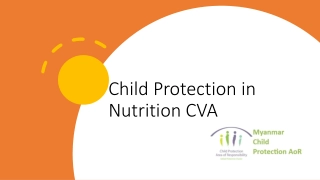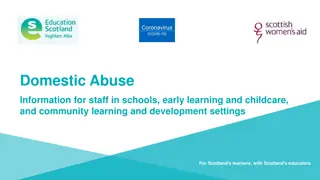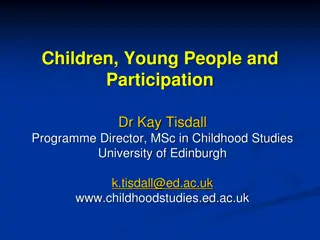Children and Young People's Participation in Child Protection: Insights and Perspectives
Explore the crucial aspects of children and youth-led social change actions in child protection, creative approaches to their participation, the contexts where participation thrives, and the significant outcomes on social work, education, policy, and collective action. Concepts like child-centrism and case selection in diverse social positions emphasize the importance of recognizing children's voices and agency.
Uploaded on Sep 15, 2024 | 0 Views
Download Presentation

Please find below an Image/Link to download the presentation.
The content on the website is provided AS IS for your information and personal use only. It may not be sold, licensed, or shared on other websites without obtaining consent from the author. Download presentation by click this link. If you encounter any issues during the download, it is possible that the publisher has removed the file from their server.
E N D
Presentation Transcript
Children and Young Peoples Participation in Child Protection: International Research and Practical Applications Katrin Kri , Ph. D., Emmanuel College Boston, USA Dr. Mimi Petersen, Copenhagen College (K benhavns Professionsh jskole), Denmark RDV Seminar Series, September 23, 2021
Children and Young Peoples Participation in Child Protection: International Research and Practical Applications, book under contract by Oxford University Press (2022), edited by Katrin Kri & Mimi Petersen Aims of the book Questions Concepts Case selection Chapters Children s participation movement in child protection Presentation outline
How have children and youth led social change actions in child protection? What are creative approaches to children and young people s participation by child protection practitioners? What are the contexts in which children s participation can flourish? What are the outcomes of children and youths participation on children and young people, social work education and practice, policy development, and children and young people s collective action? Questions
Child-centrism Skivenes & Strandbu (2006): Recognition of children s needs, interests, and views of the world The interplay between structural and interactional levels Intersectionality Crenshaw (1989; 1991) and Collins (1993): Children and young people s experiences with participation in child protection will vary depending on their social position. > Case selection: we aimed at including a heterogeneous sample of case studies that reflect differences in children s social position. Concepts Children s participation Hart (1992), Shier (2001), Thomas (2002), Archard and Skivenes (2009), and Lansdown (2010) Emphasis on creating opportunities for children s agency and power in decision-making (1) Children and young people receive information about what is going on so they can reflect and develop their views. (2) They are supported in developing a sense of agency. Their voice is heard, and their opinion is taken seriously in decision-making. (3) They work with adults as partners to initiate decisions and develop actions that lead to social change based on their views and interests.
Case selection Included presentations on children s participation given at the 2018 EUSARF conference Engaged in purposeful sampling and convenience sampling Aim: analyze children s and young people s voices and actions Aim: describe innovative participatory practice approaches initiated by children and young people, public and non- governmental organizations Aim: highlight diversity in social positions of children and geographical regions, as far as possible Aim: feature case studies that have not been widely discussed in academic English-language journals
Foreword by Marit Skivenes Part 1: Children and Youth as Change Agents Chapters Part 1: The Change Factory s Participation in Social Work Education in Norway by Roar Sundby Child-directed Child Welfare Research and Development in Denmark by Mimi Petersen Care Leavers Participation in Designing Child Welfare Services and Policy in Israel by Talia Meital Schwartz-Tayri and Hodas Lotan Children Claiming the Right to Live without Violence in Nicaragua by Harry Shier
Part 2: Participatory Professional Practices The Participation of LGBTQIA+ Children and Youth in Care in the Netherlands by Rodrigo Gonz lez lvarez, Mijntje ten Brummelaar, Kevin van Mierlo, Gerald P. Mallon and M nica L pez L pez Children s Participation in Foster Care in Germany by Daniela Reimer Children s Age and Participation in Child Protection Practice in California (USA) by Megan Canfield, Emma Frushell, Jenna Gaudette and Katrin Kri Arts-Based Research with Children in Program Evaluation in Spain by Nuria Fuentes-Pel ez, Aina Mateos, M. Angels Balsells, and Ma Jose Rodriguo The Making My Story -Project in Brazil by Monica Vidiz, Lara Naddeo, and Debora Vigevani Epilogue by Patrick Nigel Thomas Chapters Part 2:
Childrens participation movement in child protection Children and youth as agents of change Outcomes Participatory capital : resources and contexts facilitating children s participation Participatory professional practices Facilitatory roles of adults
Children and youth as agents of change Children and youth: Change law, policy, and practice approaches to professional social work based on collaborative actions and research with adults Advocate for changes in and design child protection policy Conduct research leading to changes in the child protection system Develop new social work practice models Engage in collective action against violence against children Educate future child protection professionals
Outcomes Transformative for children and youth: Shift in consciousness Children and youth gain competencies, self-confidence, and self-worth. Increase their efficacy, resilience, and empowerment, and trust in democratic political processes Gain a sense of belonging to a group by collaborating with other youth Organizational and social transformation: Changes in social work training, practice, law and policy and community and societal change
Outcomes Children and youth may find participating stressful and overwhelming, and interactions with adults intimidating. Ethical concerns about children and youths privacy and ability to consent to participate in research and social change Ambivalence and resistance from adults, who find that youth-led action may retraumatize children and youth or create an additional burden for the adults who must change their ways Financial and logistical resources and consistent and trusting relationships between children and adults who safeguard against these risks can help avoid these outcomes.
Participatory capital Facilitatory and transformative legal, policy, and practice contexts and emotional, financial, time, and logistical supports Great variation: public organizations or NGOs (for example, protagonismo infantil in Nicaragua, Nicaraguan NGO CESESMA) Varies depending on children s age, ethnicity, gender, nationality, etc. Encompasses children and youth s creativity, capacities, strengths, and skills Includes children s alliances and cooperation with other children and youth, and partnerships with adults working in non-governmental organizations, public agencies, and government entities Involves capacity-building of children, youth, and adults
Participatory professional practices Characterized by professional attitudes, relationships, and practice approaches that allow all children and youth to participate regardless of age, ability, ethnicity, gender identity, migrant background, sexuality, etc. Involve participatory attitudes towards children that are nurturing and free of biases, labeling, and stigmatizing children and youth Characterized by caring, consistent, respectful, and non-hierarchical relationships between children, youth, and adults Involve creative practice methods that combine playful visual and non-verbal modes of expression with verbal communication, which allows for the involvement of younger children > Research and practice need to play a more proactive role in finding means to make babies, toddlers, and younger children present in professional decision-making in child protection, involving their experiences and representing their interests.
Facilitatory roles of adults Adults are allies and duty-bearers in youth-led social transformation: Are involved in children and youth s capacity-building Provide logistical, financial and emotional support, analyze the risks of children and youth s actions Provide rules and safeguards for children and youth engaged in transformative research, practice, organizational and social change Provide information and recognize children as rights-holders Create relationships characterized by trust, respect, non-judgment and willingness to collaborate
Contact information:
Thank you for your attention!
References Archard, D., & Skivenes, M. (2009). Hearing the child. Child & Family Social Work, 14, 391-399. Collins, P. H. (1993). Toward a new vision: Race, class, and gender as categories of analysis and connection. Race, Sex & Class, 1(1), 25-45. Crenshaw, K. (1989). Demarginalizing the intersectionality of race and sex: A Black feminist critique of antidiscrimination doctrine, feminist theory and antiracist politics. University of Chicago Legal Forum, 1, 139-168. Crenshaw, K. (1991). Mapping the margins: Intersectionality, identity politics, and violence against women of color. Stanford Law Review, 43, 1241 1299. Hart, R. (1992). Children s participation: From tokenism to citizenship. UNICEF International Child Development Center. Retrieved from http://www.unicef-irc.org/ publications/pdf/childrens_participation.pdf. Lansdown, G. (2010). The realization of children s participation rights: Critical reflections. In B. Percy-Smith, & N. Thomas, A handbook of children and young people's participation: Perspectives from theory and practice (pp. 11-23). Routledge. Shier, H. (2001). Pathways to participation: Openings, opportunities and obligations. Children and Society, 15(2), 107-117. Skivenes, M., & Strandbu, A. (2006). A child perspective and children s participation. Children, Youth and Environments, 16(2), 10-27.























